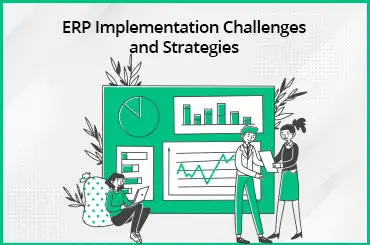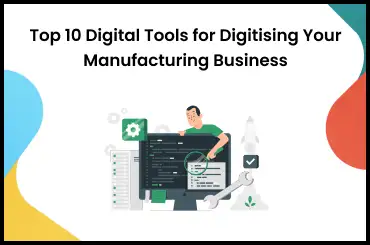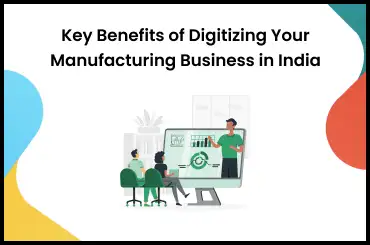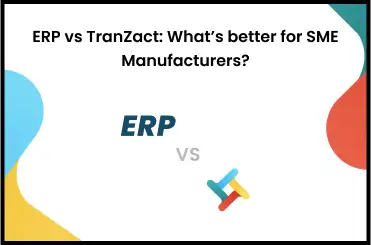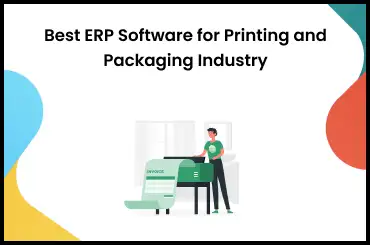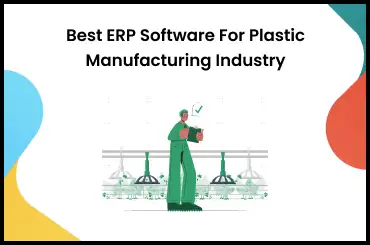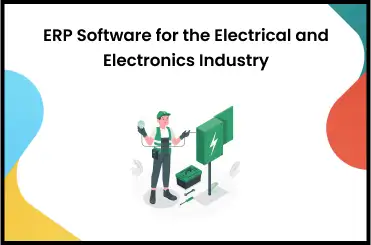For many Indian SME manufacturers, setting up an ERP system can be challenging. Without a clear understanding and proper preparation, they may face costly mistakes, delays, and even failed projects. These problems can disrupt daily operations, increase costs, and cause frustration.
In this blog post, we’ll cover the 8 key challenges and risks of ERP implementation. By knowing what to expect, manufacturers can better prepare, have a smoother process, fewer disruptions, and get the most out of their ERP system.
What Is ERP Implementation?
ERP implementation is a complex process that involves changing how a business operates, setting up the software, moving data, and training employees to use the new system. It requires careful planning, and setup, and can take several months to complete. Businesses need to clearly understand their needs, review current processes, and outline what they expect from the system to choose the right ERP. A well-thought-out plan and good preparation are key to successful ERP implementation.
Switching to an ERP system can be challenging because it means moving from manual methods to automated ones. An ERP system brings together different business processes into one place, helping departments like finance, HR, sales, and manufacturing work more efficiently.
Read How Does an ERP System Improve Business Efficiency & Performance?
Why Is ERP Implementation a Challenging Task?
ERP system is important and challenging for a business as it impacts business operations, inventory management, security management, and more. Employees must adapt to evolving ERP implementation challenges to maximize their operations. Make sure to choose an ERP software cautiously as it demands that you predetermine your business strategy for the long term.
Read What is ERP Software: Functions, Solutions, and Use Cases.
Strong project management, senior leadership support, and a dedicated project team from all segments are necessary to conduct the system. It assures that the software will serve the needs and business operations without compromising the data quality and management. These elements are essential to succeed in the implementation.
Determine the information technology (IT) strategy, build an ERP selection team to discuss the available systems, identify business requirements, assess users of ERP, develop the data management strategy, list ERP systems, and shortlist the right one to overcome the key challenges in ERP implementation.
Find the Best ERP Software in India 2024.
Key ERP Implementation Challenges
Staff facing technical difficulties and resisting change are some of the key issues in ERP implementation. Careful planning and efficient management can solve these challenges. Companies that use the ERP system for manufacturing, logistics, inventory management, human capital management, or other verticals must understand the capabilities of the ERP system.
Understanding the challenges of enterprise resource planning helps users choose an ERP system capable of handling the business's multiple prospects and operations.
Here is an overview of the eight common ERP implementation challenges that companies must take into account for a successful experience with the system:
1. Data Management
Multiple phases of ERP implementations like discovery and planning, design, development, data migration, testing, deployment, and support require precise project management and engagement from all participants.
With efficient teamwork, timescale management, and communication, businesses can achieve success in ERP implementation. Inadequate project management puts ERP adoption at risk because it gives the project to whoever is available and provides no oversight from those in control.
The inability to manage ERP functions can lead to missed opportunities in automating operations, speeding up functionality, exploiting industry-specific capabilities, and fulfilling additional targets.
2. Integration with data and processes
ERP systems provide a single, reliable source of data for the entire organization, making data migration a key part of the setup. One of the biggest challenges in ERP implementation is poor data integration, which can cause errors and problems, especially with updating live inventory.
Careful planning can keep the ERP project on track and within budget. By linking existing systems and processes with the ERP, all data in the organization is unified, saving time and avoiding the hassle of dealing with scattered information.
3. Data Quality Control
Data quality is important for companies transferring legacy data into a new ERP system. Data migration to the ERP system requires a data quality effort, as there may be discrepancies, erroneous information, redundant copies of the same information, and outdated information.
Validating the data, eliminating duplicates, filling in blanks, and properly evaluating the new data should be done to assure data quality. Teams should be divided into teams with well-defined roles, such as accounting and customer support.
4. Management of Changes
An ERP implementation requires switching between various software to ensure business operations proficiency and high security. This may pose issues and challenges in implementing ERP for change management because it needs individuals to adjust their mindsets and routine work procedures accordingly. Resistance to change can hamper the workflow of business outcomes and work.
A successful implementation depends on getting leadership and stakeholders' support early in the process. If the team does not abide by the ideals and importance of the ERP system, it can have adverse effects on the enterprise. The employees must receive thorough training and support to facilitate their acceptance of the new ERP and explain its features and benefits to all stakeholders.
5. Maintenance Costs
ERP systems require regular maintenance, which can lead to high bills. Businesses often need to pay more attention to the effort involved in switching to a new system, leading to cost overruns. Before adopting an ERP system, it is vital to consider if the program will sustain itself in the long run and if the vendor or software partner can provide appropriate support for several years.
Businesses often use a software vendor services team or outside consultants when internal resources are limited. Expert ERP implementation challenge consultants usually charge per hour basis plus transportation expenses for system management. Data migration fees may account for up to 10% of the project budget. Maintenance costs include staff training expenses and features paid for basic training and additional training sessions or classes.
6. Inadequate Guidance When Vetting Vendors
Before choosing new software, it's important to carefully evaluate and compare several vendors to find the best fit for your business. Picking the first option you see can cause problems later. Talking to multiple vendors gives you a better understanding of each system's pros and cons.
You need to be aware of the system's limitations and the potential challenges during ERP implementation. Consider how these factors might affect your current processes and practices. Properly vetting vendors helps you choose a solution that meets your needs and prepares you for any difficulties that might happen during the implementation. This careful selection process is essential for a smooth transition to your new ERP system.
7. Lack of Efficient Planning
Companies must pay more attention to the time and resources required for successful implementation, leading to scope and staffing needs. A robust and practical plan can help prevent these problems, ensuring prompt and effective decision-making. The project will stay on track with a realistic plan that overcomes potential hiccups and withdraws the issues beforehand. It can overcome cost overruns and lack of employee training.
8. Flexibility and Continuous Improvement
An ERP system needs to be flexible to integrate various software and departments smoothly. It should meet different needs, handle data well, and alert you about issues. Choose a customizable ERP system to avoid the rigidity of a system that might not meet future needs.
ERP systems must adapt to changing business needs and new technology. A dedicated team should manage the system, resolve issues, and make improvements as needed. On-premise systems are harder to upgrade than cloud-based ones, so choose the right ERP with all the necessary features to avoid implementation challenges.
ERP Problems and Solutions
Setting up an ERP system can help a business a lot. However, there are risks of implementing an ERP system. Here's a look at some common ERP problems and solutions:
Problem: Deciding What to Integrate
- Challenge: A big ERP integration challenge is figuring out which current processes should be part of the ERP system and which shouldn't.
- Solution: Talk to different teams in the business. Find out what they need and make a plan for the ERP system that includes these needs.
Problem: The ERP System Isn't Flexible
- Challenge: If the ERP system can't change easily, the business might face software implementation challenges.
- Solution: Pick an ERP software that fits the business well. This way, it can work smoothly with the current way the business runs.
Problem: People Don't Like Change
- Challenge: Workers might not want to use a new system. This is one of the challenges of ERP.
- Solution: Train everyone well. Show them how the new ERP system will make their jobs easier.
Problem: Picking the Right Vendor
- Challenge: Sometimes, businesses pick an ERP vendor too quickly and later find ERP implementation issues.
- Solution: Take time to check different vendors. Talk to a few of them before deciding which one to go with.
Problem: Keeping the ERP System Running Costs Money
- Challenge: After setting up the ERP system, there are costs to keep it running. This adds to the ERP implementation risks.
- Solution: Plan for these costs from the start. Make sure the vendor will help and support the business for a long time.
Problem: Not Using All the Features
- Challenge: Sometimes, people don't know about all the things the ERP system can do.
- Solution: Have regular training. Make sure everyone knows how to use the system to its full potential.
Setting up an ERP system has its challenges. But with the right planning and solutions, a business can handle the ERP implementation risks and ERP implementation issues. By understanding the software implementation challenges and ERP integration challenges, businesses can use their ERP system well and get all its benefits.
Overcome ERP Implementation Challenges With TranZact
ERP systems can help improve profits and customer satisfaction, but they often require a lot of time, effort, and resources. For Indian SME manufacturers, TranZact offers a better solution. Unlike traditional ERPs, TranZact is built specifically for Indian SMEs, digitizing processes from enquiry to dispatch, making it easier to manage your manufacturing operations. TranZact helps you streamline your processes, reduce implementation headaches, and provides smart reports and dashboards to support your business growth.
Next, read How TranZact Can Digitise Your Manufacturing Business: A Comprehensive Guide
FAQs
1. Why is ERP implementation a challenging task?
Implementation challenges in ERP prevail as it plays a wide-scope role in businesses and is connected to all key business functionalities. Some critical issues may also occur due to data loss if not saved properly, the learning curve for employees, and ERP costs.
2. What makes an ERP implementation successful?
Project planning, analyzing software capabilities, data management, adequate training, and testing are vital aspects of ensuring successful ERP implementation.
3. What is the significance of determining processes for ERP integration?
The initial step in ERP implementation is to discern which processes and systems would benefit from ERP integration and which might hinder the business workflow. Without an ERP system, employees often spend excessive time gathering data scattered across various sources. Integrating processes with an ERP ensures a singular data source for the entire organization.
4. Why might there be resistance to ERP implementation within an organization?
People are generally resistant to change, especially when it involves transitioning from a familiar system to a new one. If the team doesn't understand the rationale behind the shift to a new ERP system, the implementation process can become more challenging. Proper training and emphasizing the benefits of the ERP system can help mitigate this resistance.
5. How does the flexibility of an ERP system impact its implementation?
If an ERP system lacks flexibility, businesses might have to modify their processes to ensure compatibility. It's essential to choose software tailored to the company's specific needs to prevent issues related to inflexibility during ERP implementation.
6. What are the concerns related to the costs of maintaining an ERP system?
While an ERP system might seem cost-effective initially, the maintenance costs can add up over time. It's crucial to consider these ongoing expenses before integration. Additionally, ensuring that the chosen software will receive long-term support from the vendor or software partner is vital.
7. Why is data migration a critical aspect of ERP implementation?
Data migration is essential as it involves transferring both structured and unstructured data from the source system to the ERP software. Unstructured data requires additional processing to ensure its accuracy. Proper planning is necessary to determine the data types needed for the new system and to ensure a smooth migration process.
8. How does poor project management affect ERP implementation?
Inadequate project management can pose significant risks during ERP implementation. If the project doesn't receive proper oversight and resources, it might not achieve its intended outcomes. Proper management and allocation of resources are crucial for the successful implementation of an ERP system.
9. Why is it challenging to redesign current processes to fit the new ERP software?
While it might be tempting to adjust the new ERP system to existing processes, this approach is often not successful. The most efficient method involves customizing the ERP system to cater to specific business needs. However, both changing existing processes and customizing the ERP system can be time-consuming and costly.







